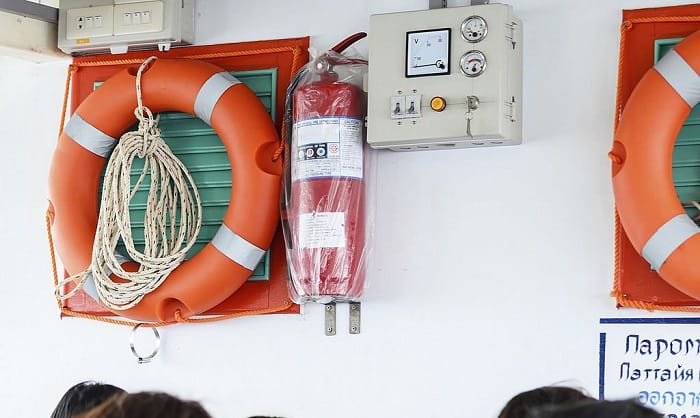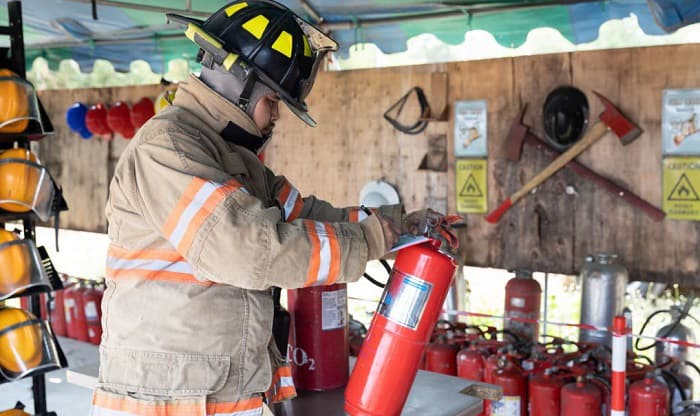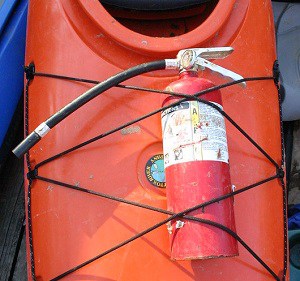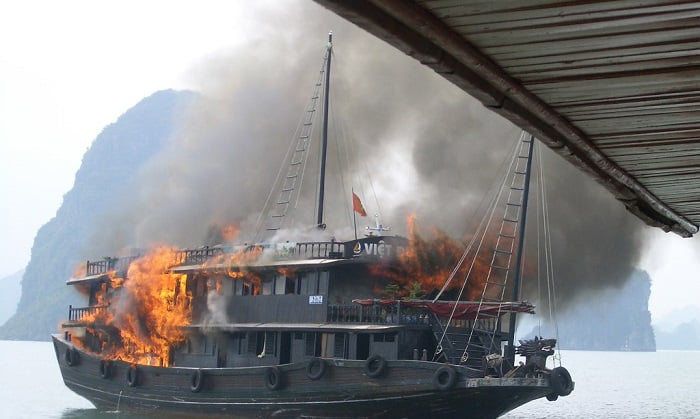Maritime fire protection guidelines change over time so it’s only right to take the time to know what is a requirement for fire extinguishers on a boat currently.
Based on the new fire extinguisher regs released on April 20, 2022, no Class B portable marine fire extinguisher should exceed 12 years of service and should be in good, serviceable condition. This means:
- It isn’t seriously corroded and damaged and has a clean, unobstructed discharge nozzle.
- The safety pin is in place.
- It’s properly charged and is indicated as such.
What about the number of fire extinguishers? Well, that hasn’t changed. Read on to know all USCG-approved boat fire extinguisher requirements.
Table of Contents
What Type of Fire Extinguishers Should Be Used in Recreational Boats?
I already mentioned that the class B portable fire extinguisher is the recommended type of fire extinguisher for a boat. That’s the only type you can have on board, so be sure you buy only 5-B, 10-B, or 20-B extinguishers.
Take Note:
- The number on these extinguishers indicates their respective coverages. A 5-B extinguisher’s nozzle covers 5 square feet (with its nozzle ability to turn from side to side), while a 20-B one offers 4x as much with 20 square feet of coverage.
- B1 fire extinguishers are equivalent to 5-B, while B2s are 10-B.
There have been recent recommendations to add class A and C extinguishers as well but, as of this writing, they’re not part of the coast guard requirement yet.
According to the updated guidelines, class B extinguishers are still sufficient for optimal fire protection in maritime conditions.
This class of fire extinguisher can handle fires that usually happen inside recreational vessels, such as those that are the result of oil leaks, faulty battery cables, and voltage regulators.
What Determines the Number of Extinguishers You Should Carry?
The number of fire extinguishers on a boat is usually dictated by the size of the vessel and whether it has a fixed system. If it doesn’t, here are the guidelines:
- Vessels that are smaller than 26 feet should have one valid fire extinguisher on the boat. So, as an example, an 18-foot powerboat with installed fuel tank(s) should have at least one 5-B or 10-B fire extinguisher.
- Boats spanning 26 and 40 feet should have two 5-B or 10-B or one 20-B.
- Those that are as large as 40 and 65 feet should use three 5-B or 10-B. Another alternative is opting for one 20-B and complementing it with a 5-B or 10-B.
Vessels with fixed extinguishing systems, assuming they’ve been approved, should take note of these specific requirements to know how many fire extinguishers they should carry:
- If they’re less than 26 feet, they won’t need to carry additional fire extinguishers.
- 26 to 40-footers need one 5-B or 10-B.
- 40 to 65-footers need two 5-B or 10-B or a single 20-B.
Where Should Fire Extinguishers Be Located on a Boat?
The best practice is to keep them upright in the rooms where fires are likely to occur. Consider all the flammable substances you have onboard, like gas tanks, alcohol, paint thinner, among others.
In most cases, this includes the majority of the hull and main cabin. Just like in a home, people should have ready access to extinguishers.
Other Key Takeaways
- The recent April 2022 update to fire protection guidelines separated the requirements for commercial and naval vessels and their recreational counterparts. This was done to ensure easier regulation of the latter.
- It’s just as important to be proactive in fire prevention while sailing. I suggest you take the time to watch this video to know a couple of helpful tips:
- One of the key steps to take is maintaining your fire extinguisher. Be sure to limit its exposure to the elements and know what to do with an undercharged or overcharged fire extinguisher. If that’s the case, it’s best to have it replaced altogether.
Conclusion
To wrap things up, stick to class B extinguishers for your vessels. Bring along the required number based on the size of your boat and the recommendations we shared above.
Don’t forget about placing them in the most hazardous places and keeping them in good, working condition.
With all things considered, it’s good that you’re researching what is a requirement for fire extinguishers on a boat. Knowing the present guidelines on fire extinguishers is a must to ensure continued adherence to maritime law and everyone’s safety onboard.

“My intention from the first day establishing Boating Basics Online is to provide as much help as possible for boaters who want to experience a first safe and convenient trip. So feel free to join us and share your beautiful journeys to the sea!”




